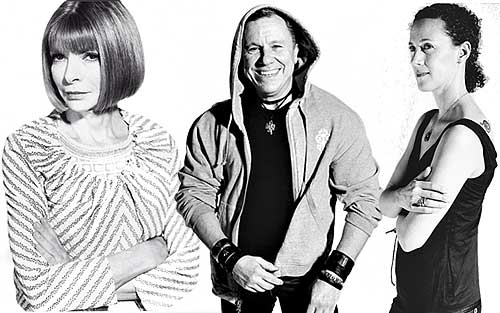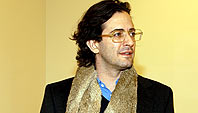
Anna Wintour
Editor-in-chief, Vogue
Vogue, c’est moi. No fashion figure has ever played her power as strongly and cannily as the feared, respected, sharply intelligent Wintour. She can make a fledgling’s career in a single phone call (designers from John Galliano to Zac Posen owe her a debt of gratitude), anoint the next society muse (Lauren duPont, Jessica Joffe), and raise millions for her favorite causes ($26 million for the Met’s Costume Institute in the past eleven years, $14 million for various AIDS charities). And let’s not forget her burgeoning empire (Teen Vogue, Men’s Vogue, Vogue Living). Even paint-wielding peta activists and a whiny roman à clef can’t touch her. In fact, she’s been an inadvertent boon to the publishing industry, since The Devil Wears Prada spawned its own subgenre of chick lit.
Peter Marino
Architect
The premier set designer for the luxury-shopping experience, ever since he did Barneys’ uptown flagship back in 1992. His style—clean lines, neutral colors, a careful balance of textures to keep the eye interested—has worked for names like Giorgio Armani, Christian Dior, Louis Vuitton, Fendi (for whom he oversaw a $25 million rebuilding of its Rome store), and Chanel, all of which have used him to design their New York flagships. For many, he’s created the worldwide retail template, which is why that pale pickled oak you see in Chanel’s 57th Street store is precisely the same shade of pickled oak in Chanel’s Tokyo tower.
Kim France
Editor-in-chief, Lucky
With Lucky, France has broken the wall between magazine and catalogue—and thus changed how clothes are bought and sold, all the way to the factory floor. And it works; if it’s in Lucky, it moves.
Ralph Lauren
CEO, Polo Ralph Lauren
We’ve been in so deep for so long that it can be hard to get perspective, but Ralph Lauren’s depiction of an immaculately groomed, mouthwateringly merchandised America (with strong British overtones) has altered the way we see our own culture. He made it irresistible in the stores, too, to the tune of $3.3 billion last year in categories as diverse as paint, perfume, and bespoke suits. He’s even managed to sell the vision back to its roots: Starting this summer, Polo is the official wardrober for all of Wimbledon’s on-court personnel.

Marc Jacobs
Head designer, Marc Jacobs International
Quietly, modestly, totally, Marc Jacobs has taken over. You see him everywhere, from the army jackets (even if yours is from H&M, it is, in a sense, by Marc) to the ubiquitous slouchy leather bags to the transformation of that once-sleepy stretch of Bleecker Street. In his other gig, as creative director of Louis Vuitton, he’s single-handedly made that brand the most profitable of parent company LVMH’s fashion stable. You may not immediately swoon for what he shows on the runway (ballooning volumes and bulky layering for fall, for example), but by the time the season changes, you will. Fashion: Julie Gilhart, Terry Lundgren, Elie Tahari …

Terry Lundgren
CEO, Federated Department Stores
The department store was in danger of becoming irrelevant to American shoppers increasingly trained to go to Costco, Target, or Wal-Mart. By keeping prices down and glitzy brand names front and center (Federated just signed a big home-furnishings deal with Martha Stewart), Lundgren, who controls 850 stores (Macy’s, Bloomingdale’s, and just about everything else), is reinventing the form.
Mary Catalina
Vintage dealer
Designers like Oscar de la Renta and Anna Sui turn to Catalina’s vast, well-organized collection of vintage clothes and fabric swatches for inspiration (occasionally putting the piece itself on the runway), which means that right now, somewhere in her studio is what you’ll be wearing next spring.
Marc Ecko
Founder, Ecko Unlimited
Press-hungry antics like his current First Amendment lawsuit against the city make Ecko seem more clown than kingpin, but he’s the top dog in hip-hop fashion, even though the competition (P. Diddy, Russell Simmons, Jay-Z, and Damon Dash) has infinitely more name recognition. Ecko got in early (his line launched in 1993) and knows how to monopolize his consumer. He sold his oversize shirts at skate shops, thus cross-breeding two potent teen cultures, and founded a bi-monthly shopping magazine for men called Complex that’s actually successful.
Julie Gilhart
Fashion director, Barneys New York
As fashion director of the most forward-thinking big store in the city, Gilhart is responsible for feeding customers a constant diet of the new and lust-worthy. She does this by trekking to designers’ studios and then championing those she thinks have the proper balance of real design skill and luxury. She could easily delegate the searching to underlings, but—yes, that’s Gilhart in the front row of some obscure student’s wobbly first attempt. She’s promoted Alber Elbaz (now a star at Lanvin after a rocky few years), Proenza Schouler, Olivier Theyskens, Goyard, and Project Alabama, to name a few. And with Barneys expanding across the country, Gilhart’s effect is going national.
Andrew Rosen and Elie Tahari
Founders, Theory
In 1997, they started a line of cleanly tailored stretch fabric separates and made it possible for thousands of women to finally put their work wardrobes on autopilot.
Thom Browne
Designer, Thom Browne New York
To the uninitiated, Thom Browne’s flood-watch trousers and skinny jackets are geek revisited. But his shrunken preppy look is having a ripple effect—see Brooks Brothers’ newest suit silhouette, the Fitzgerald, with its high armhole, slim cut, and skinnier pant. Next: The Influential Scenesters